4 November, 2001
Since I had sea ice training yesterday, I was invited to go with the divers
as they went on a dive to collect samples of foraminifera and algae at Cape
Evans near Scott's hut. Dr. Pollock and Phil Forte (whose job away from
Antarctica is to pilot the "Alvin" deep-sea submarine), got suited up to
dive. The dive hole had to first be cleared of sea ice. The divers had
about three layers under their dry suits as they went into 28 degree
Fahrenheit water.
The strong wind was cold enough to make the group find shelter from time to
time in the warm orange vehicles called Sprytes. While the divers were
down under the ice, the rest of the group visited the historic Scott hut.
It was amazing to see this 90 year old hut in remarkably good condition.
It seemed that Robert F. Scott, the expedition leader who died on the way
back from the South Pole in 1911, could walk in at any minute. The boots
filled with hay to keep them dry, the lantern by Scott's bed, penguin eggs,
and the penguin on the worktable seemed to suggest that someone would be
coming back soon.
After leaving the dive site, the group encountered a lone Adelie penguin
walking toward us down the
ice road. The road, marked by green flags to show the safest route, didn't
prevent the little tuxedo-suited penguin from tripping on the ice. After
the penguin fairly raced across the land, we went on to the ice caves. The
entrance of the cave led into a sculptured room with ice crystal formations
hanging from the ceiling. The blue ice made the place look magical.
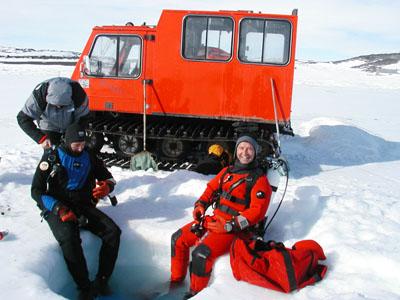
Dr. Neil Pollack from Duke University and Mr. Phil Forte from Woods Hole Oceangraphic Institute, prepare to dive in the 28F water at Cape Evans. The ice here is 10 feet thick!
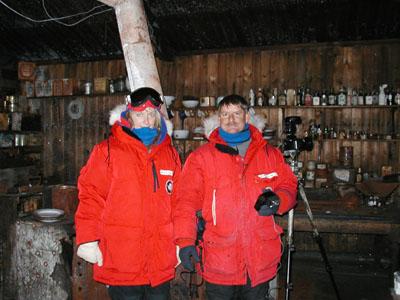
Dr. Steve Alexander and his wife Jennifer standing in the historic hut of explorer Robert Falcon Scott, who died on the return from the South Pole in 1911.
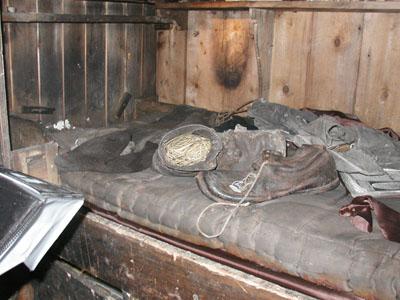
An old boot of one of Scott's team. Notice the sennegras lining the boot - it insulates and draws away moisture from the foot in the freezing conditions.
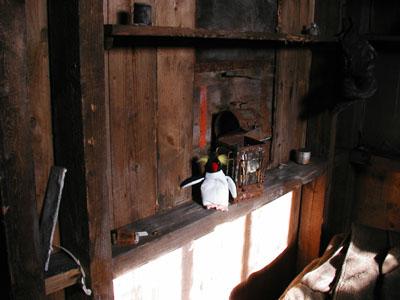
Spike sitting next to Scott's bedside lantern. This lantern is one which Scott read bywhile passing away time in the long, dark Antarctic winter.
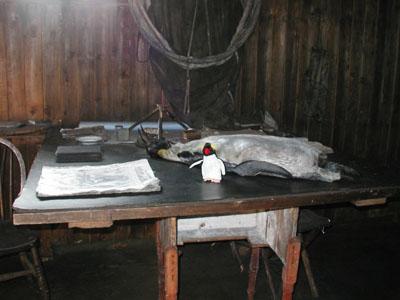
Spike next to a stuffed Emperor Penguin on the chart table of Scott. Edward Wilson, the biologist on the expedition, studied the Antarctic wildlife, and his drawings remain some of the best ever done to this day.
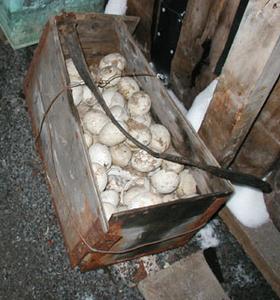
Emperor Penguin eggs at Scott's hut. These eggs were collected on an expedition to the Emperor rookery at Cape Crozier during the Antarctic winter. The men nearly lost their lives when their tent was blown away and they had to live in a stone and ice igloo. Apsley Cherry Garrard wrote the book "The Worst Journey in the World" based on this egg collecting trip.

Tina and Berrita at the entrance to an ice cave. This cave is part of a crevasse in the Erebus Ice Tongue - a glacier which extends out to sea.
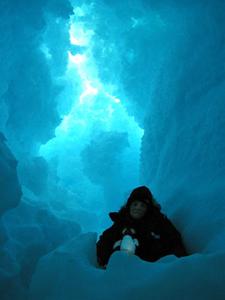
Tina and Spike inside a glacier. This cave is lined with perfect ice crystals which form from "hoar frost" - water vapour which goes from the gaseous to solid form without becoming water. These crystals are the most perfect water crystals one can find due to Antarctica having the purest air on the planet.
Contact the TEA in the field at
.
If you cannot connect through your browser, copy the
TEA's e-mail address in the "To:" line of
your favorite e-mail package.
|
